Introduction – Infrared Quartz Heaters
[Update: 1/13/2024 we added cost efficiency information comparing infrared heater types against 4 other types of heating devices]
Infrared quartz heaters are not very efficient. If you just wanted to understand that, then your search is over. If you’d still like to get one, we review 3 below. To understand why they’re not efficient, read on. Basically if you restrict yourself to an electric heater, you’re not getting a lot of efficiency out. The only electricity based heating that is efficient are the heat pumps.
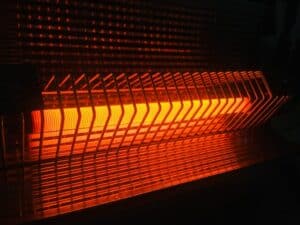
But I Keep Reading That Infrared Heaters Are 100% Efficient!
It’s important to clarify what we mean by “efficient” – here we take what the average person would be most concerned with: cost. Therefore, cost efficiency means that given the same dollar, the amount of heat that is put out is maximized. You can read below in one of the comments from an engineer below who is very concerned that we say infrared heaters are not efficient, but that is really missing the point.
To illustrate the point, here we computed the cost efficiency of 4 major heating device types. We even assume that infrared heaters are 100% energy efficient – although in reality they will be a bit less than 100% like other electric furnaces, which are in the first row:
| Device | Fuel | Energy Efficiency | Fuel Cost | Energy Density | Cost Efficiency per million BTU |
|---|---|---|---|---|---|
| Electric Furnace | Electricity | 98% | $0.17 / kWh | 3412 BTU / kWh | $50.84 |
| Fuel Oil Furnace | Heating Oil | 78% | $3.965 / gal | 138500 BTU / gal | $28.62 |
| Natural Gas Furnace | Natural Gas | 82% | $16.70 / 1000 cu ft | 1036000 BTU / 1000 cu ft | $16.12 |
| Air Source Heat Pump | Electricity | COP 3 | $0.17 / kWh | 3412 BTU / kWh | $16.60 |
| Infrared Heater | Electricity | 100% | $0.17 / kWh | 3412 BTU / kWh | $49.80 |
Therefore, even though an infrared heater is 100% efficient in converting electricity to heat, it turns out to be a terrible way to generate heat on a cost basis. Converting natural gas to heat by burning it, or by moving heat from the outside to inside as with a heat pump, turns out to use less energy than that of the infrared heater on a per dollar basis.
This is not true of course, if you have abundant power for example with your own solar panels and are not so worried about being cost efficient. But in that case, maybe you’re not concerned about energy efficiency either!
Infrared Heaters Emit Infrared Radiation – Which Is The Same As Heat
In more detail, quartz heaters are electric heaters that use infrared radiation to produce heat. These heaters are also sometimes called infrared emitters or infrared panels. Infrared radiation is a type of electromagnetic radiation that is made up of oscillating electric and magnetic fields. It’s also just another name for “heat”!
This radiation is invisible to the human eye but can be felt as heat. Infrared quartz heaters convert electricity into infrared radiation and then emit this radiation into the room. Our verdict at ShrinkThatFootprint is that you’re not getting too much efficiency out of this type of heater compared to a regular electric heater, and moreover, electric heaters are incredibly inefficient so we don’t recommend using it unless you absolutely have no choice.
How Do Infrared Quartz Heaters Work?
Infrared quartz heaters have some popularity due to their supposed efficiency and low operating costs. But how do they work? Essentially, an infrared quartz heater works by using electrical energy to generate heat waves. The heat that comes out and warms the room is a process is similar to how the sun’s rays warm our skin.
When invisible light waves contact an object, they cause the atoms in that object to vibrate, creating heat. In this sense, infrared quartz heaters are just like regular resistive electrical heaters in that the infrared light is directed out and warms up the air.
Additionally, infrared quartz heaters do not rely on convection to circulate the air, they are much quieter than traditional heating systems. So if you’re looking for a way to save money on your heating bills and enjoy a more comfortable home, an infrared quartz heater may be the perfect solution.
How Much Electricity Do Infrared Quartz Heaters Use?
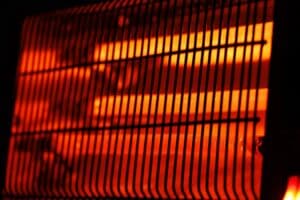
Quartz infrared heaters are just as energy inefficient as regular electric heaters. So if a regular electric heater is 1500 W, then you can expect an infrared heater to be about the same. They’re also not that environmentally friendly because the carbon intensity is far lower than a solar powered heater or a heat pump.
An infrared quartz heater rated at 1,500 W will generate 1.5 kWh of heat energy per hour. That’s 5,118 BTU per hour. A fairly average home requires 20,000 kWh heat per year, concentrated in the winter months from October to March. Therefore a single heater would only be able to supply enough heat for a very small part of the house.
Another downside of infrared heaters is that they can be more expensive than other heaters. However, they typically last longer, so they may be more cost-effective in the long run; if you’re considering an infrared heater, research to find the best model for your needs.
Why Aren’t Infrared Quartz Heaters More Efficient Than Others?
Infrared heaters are becoming increasingly popular as people look for more efficient ways to heat their homes. Infrared quartz heaters work by emitting electromagnetic waves that transfer heat directly to objects in the room rather than heating the air around them.
The heating element, instead of being wrapped in ceramic like traditional heaters, is wrapped in quartz. The reason why quartz is supposed to be good is because its highly transparent to infrared radiation. Impurities will dampen it. But basally, compared to glass, the transmittance coefficient is high. Hence there’s little loss and that heat makes it out of the heater easily.
However, there’s no benefit from being able to transmit infrared light. Even if the heating element were perfectly non-transmissive, it will absorb all the infrared and then reradiate it to the room. The only advantage may be that the infrared heater works much more quickly, because there’s no delay with the intermediary warming up of the heating element.
Rare Report Of Eye Damage
We don’t really see the quartz heaters as being any less safe than other types of electric heaters. They are probably as safe regular heaters, as they don’t produce any carbon monoxide or other harmful gasses. However, there’s a single report in the scientific literature about a 41 year old woman who experienced retina damage from staring at her infrared heater. We can only guess that this was due to too much heat because that’s the only kind of radiation coming out of this. You can read the the study in the journal Medicine 2017 by Zheng and Liu.
The Few Benefits Of Using Infrared Quartz Heaters
There aren’t many benefits of using infrared quartz heaters. They’re as durable and long lasting, making them a wise investment for any home. Here are a few more specific benefits of using infrared quartz heaters:
1. Infrared quartz heaters are as inefficient as regular heaters. They use just as much energy than traditional electric heaters methods though we acknowledge perhaps they heat a room more quickly. Additionally, they maintain a consistent temperature.
2. Infrared quartz heaters emit soft, natural light. This makes them ideal for use in bedrooms or other areas where you want to create a relaxing atmosphere. The light is also beneficial for people who suffer from the seasonal affective disorder (SAD), as it can help to improve mood and increase energy levels.
3. They are safe in-so-far as they do not produce harmful fumes or gases.
4. Lastly, infrared quartz heaters are durable and long-lasting. With proper care, they last many years without needing to be replaced. This makes them an economical choice for anyone who wants to enjoy the benefits of using an infrared heater.
How To Choose The Best-Infrared Quartz Heater For Your Needs?
There are a few things to consider when choosing an infrared quartz heater. The first thing to consider is the room size you will be using the heater. Infrared quartz heaters come in various sizes, so it is important to choose one that can heat the entire room.
The second thing to consider is the wattage of the heater. The higher the wattage, the more powerful the heater will be. However, it is important to choose a heater with a wattage that is appropriate for the size of the room. The third thing to consider is the type of controls the heater has. Some infrared quartz heaters come with remote controls, while others have manual controls. It is important to choose a heater with controls that are easy to use and understand.
Finally, it is important to read reviews of infrared quartz heaters before purchasing. This will help you find a high-quality and durable heater. Follow these steps, and you will be sure to find an infrared quartz heater that meets your needs and budget.
Our Recommendations
Given these factors, here are 3 infrared quartz heaters we review and recommend.
1. TURBRO 50” Smart WiFi Infrared Electric Fireplace
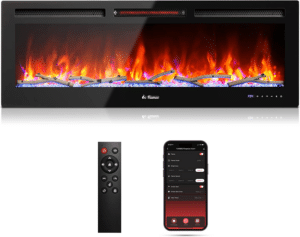
The TURBRO In Flames INF50W-3D is a corded electric infrared quartz heater, designed for wall mounting. Its dimensions are 4.6″ deep, 50″ wide, and 18″ high. The heater is made of resin material with a powder-coated finish.
One of its main features is the smart app and voice control, which allows it to work with Alexa, Google Assistant, and smartphone apps. This means it can be controlled via remote control, touch panel, voice command, or through your phone.
This heater simulates the visual and auditory experience of a real burning bonfire, complete with flame and firewood crackling sounds. The flame color, ember bed color, flame speed, and brightness are adjustable for varied combinations. It also offers three levels of sound options.
The unit produces 1500 W or 5118 BTUs per hour and is about the same efficiency as any other electric resistive heater. The heater can be recessed or wall-mounted, comes with a 5.9 feet long cord, and should be at least 6” away from the floor and 8” from the mantel or ceiling bottom.
For safety, the TURBRO In Flames INF50W-3D is certified by CSA (Certification Number: 80096056). It features overheating protection that automatically shuts off the heater if it gets too hot, and a child lock function to prevent children from tampering with the unit.
2. Dr Infrared Heater Portable Space Heater, 1500-Watt
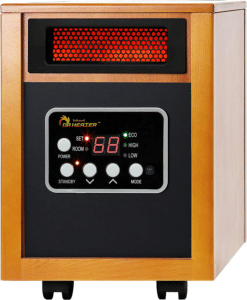
This second quartz heater is a high-capacity, corded electric model designed to heat large rooms efficiently. One of its standout features is the Auto Energy Saving Mode with high and low options, providing flexible heating power while minimizing energy use for a range of 50 to 85 degrees.
This heater offers a Dual Heating System consisting of an infrared quartz tube and PTC (Positive Temperature Coefficient) technology, which enhances its heating capacity by 60% more than some other heaters. We actually don’t understand what this means because the specs say that it delivers approximately 5200 BTUs, which is exactly what any 1,500 watt (1.5 kW) heater should produce.
For safety, it also features a 12-hour automatic shut-off timer for added safety and energy efficiency. The heater also includes tip-over and overheat protection features.
For user convenience, this heater comes with an infrared remote control and a high-pressure low-noise blower. With a noise level of 39 dB, it operates quietly despite its power, ensuring a comfortable and disturbance-free environment.
The heater weighs 24 lbs, uses 12.5 Amps of power, and has a power rating of 1500 Watts. The electric cord measures 72 inches (6 feet) in length, providing ample reach for convenient placement. The unit operates at a voltage of 120 Volts.
3. Sunwave 3000 Watt Infrared Patio Heater Tungsten Ultra Quartz
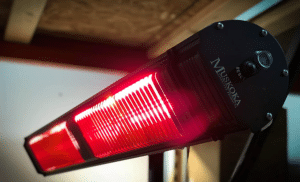
The Muskoka Lifestyle Products heater is a robust model specially designed for both indoor and outdoor use. It operates on AC 220 Volt power. One of its key features is the IP65 weatherproof rating, ensuring it can withstand weather elements.
For user convenience, this heater is remote-controlled, offering on/off switches and three temperature settings: High, Medium, and Low.
The unit comes with an adjustable wall mount bracket for versatile installation. Optional stands are available for the Solar Comfort model, sold separately.
This heater uses patented Gold Coated Ultra Quartz high heat elements to maximize heat output. It incorporates two Gold coated Halogen low glare shortwave infrared technologies along with patented parabolic heat reflectors. This combination makes it stand out from competitors, offering heat output that has been tested and lab-certified to be upwards of 40% more efficient.
But this claim is hard to evaluate – naively interpreted that would mean 3,000 watt output but using only 1,800 watts of electricity which doesn’t seem possible. More likely they mean that whatever other infrared quartz heaters are losing in terms of inefficiencies, they have slightly less losses, but without measurement data from the company this claim is hard to substantiate.
In terms of technical specifications, it operates at 3000 Watts (220~240V) (which makes it a standard electric heater with the expected power draw, with a 15 amp draw at 60Hz. The UL electrical plug type is JT2-3 6-15P, and the electrical cord specification is 15A 250V SJTW16AWx3C. The unit weighs 15 LBS.
Tips For Using Your Infrared Quartz Heater Safely And Effectively
As infrared quartz heaters have become increasingly popular, it is important to ensure they are used safely and effectively. Here are some tips to help you make the most of your infrared quartz heater:
- Be sure to read the manufacturer’s instructions carefully before using the heater.
- Place the heater on a level surface and keep it away from flammable materials.
- Make sure that the room you use the heater in is well-ventilated.
- Never leave the heater unattended while it is in use.
- When you are finished using the heater, turn it off and unplug it from the wall outlet.
- Following these simple guidelines, you can enjoy all the benefits of your infrared quartz heater without any safety concerns.
Summary
In conclusion, infrared quartz heaters are not that efficient.

There is a massive amount of misinformation on this site. Electric heaters for a start are extremely efficient and infra red heaters are even more efficient. Almost all electrical products produce waste heat which is what reduces there efficiency (as efficiency is nothing more than a ratio expressed as energy in/useful energy out). For an incandescent light bulb for example the efficiency is only 2% because 98% of the input energy goes to heat. For a heater, every single quanta of energy going in is converted to heat and therefore efficiency is almost 100% as the heat is the desired output. Admittedly there is a difference in radiative efficiency and overall efficiency. Radiative efficiency is lower as some of the heat will be absorbed by the material making the device and may not be directed at the target, but the heat will still go into the room. If it is outside this heat that is not directed may conduct through the device into the air which in turn could convect away from the target and this would technically be reducing the efficiency. Depending on the wavelength of the infra red heater, almost no energy is converted into light and if the wavelength is near infra red, almost none of the energy interacts with the air between the source and the target. Also, the units kWh is a unit of work done per unit time. So 1500W appliance (1.5kW) does not equate to 1.5kWh unless it is on for 1 hour. A Watt is one joule per second so work done is energy per unit time. A home would need a value of kW per year, not kWh per year. kWh is generally used to denote the total capacity of potential work done (like in a battery).
My idea of efficiency is feeling comfortable in very warm clothes for the lowest level of Watts. A quartz heater without a fan can heat two people at 400-800 Watts at 45 degrees indoors. In a small room you would need at least a 1500 Watts space heater and in a big room forget it.
Unfortunately the fanless ones are getting hard to find. We use the same Dlux heaters for five years but we can’t find them on Amazon now.